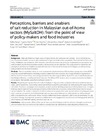| dc.contributor.author | Harun, Zaliha | |
| dc.contributor.author | Shahar, Suzana | |
| dc.contributor.author | You, Yee Xing | |
| dc.contributor.author | Manaf, Zahara Abdul | |
| dc.contributor.author | Majid, Hazreen Abdul | |
| dc.contributor.author | Chia, Yook Chin | |
| dc.contributor.author | Haron, Hasnah | |
| dc.contributor.author | Michael, Viola | |
| dc.contributor.author | Sukiman, Noor Shahida | |
| dc.contributor.author | Taib, Aida Farzana Mohamad | |
| dc.contributor.author | He, Feng J. | |
| dc.contributor.author | Brown, Mhairi K. | |
| dc.date.accessioned | 2023-05-25T09:55:36Z | |
| dc.date.available | 2023-05-25T09:55:36Z | |
| dc.date.issued | 2023-02-09 | |
| dc.identifier.citation | Harun, Z., Shahar, S., You, Y. X., Manaf, Z. A., Majid, H. A., Chia, Y. C., Haron, H., Michael, V., Sukiman, N. S., Taib, A. F. M., HE, F. J., & Brown, M. K. (2023). Perceptions, barriers and enablers of salt reduction in Malaysian out-of-home sectors (MySaltOH): from the point of view of policy-makers and food industries. Health Research Policy and Systems, 21(1), 17. | en |
| dc.identifier.issn | 1478-4505 | |
| dc.identifier.uri | https://aecc.archive.knowledgearc.net/handle/123456789/185 | |
| dc.description | Legal Note: Available under License - Creative Common Attribution: https://creativecommons.org/licenses/by/4.0/ | en |
| dc.description.abstract | Background
High salt intake is a major cause of hypertension and cardiovascular diseases. The out-of-home sectors have been identified as one of the contributors of high salt intake in the population. The National Salt Reduction Policy of Malaysia was initiated in 2015; however, out-of-home sectors are yet to be emphasized and perception by policy-makers and the food industries towards salt reduction are yet unknown. This study aimed to determine the perceptions, barriers and enablers towards salt reduction in the out-of-home sector in Malaysia, as well as among policy-makers and the food industries.
Methods
This is a qualitative study via semi-structured in-depth interviews (IDI) and focus group discussions (FGD) involving several stakeholders consisting of policy-makers from five ministries, five nongovernment organizations (NGOs) and food science/food technology researchers from five regions (West, North, East, and South Peninsular and East Malaysia/Borneo), as well as the food industries. The IDI and FGD sessions were recorded, transcribed verbatim and analysed thematically using Nvivo software version 12.
Results
All participants agreed that salt intake in Malaysia is high and leads to hypertension and cardiovascular diseases. Lack of awareness, poor eating culture and behaviour and frequent eating out were among the causes of high salt intake. Awareness campaigns and education, sodium content labelling and product reformulation were strategies that have been implemented by the government; whilst for the food industries, some of them have tried to reduce salt and labelled the sodium content on their food products. However, there were several barriers including perceived poor consumer acceptance, lack of knowledge and resources, and challenges in reformulation, as well as unavailability of guidelines and salt targets. Hence, several enablers have been suggested, which include prioritizing the salt reduction strategy, creating more awareness, collaboration and engagement, research and technology particularly for reformulation and shelf-life stability, incentives and salt tax.
Conclusions
Salt reduction efforts of the out-of-home sector in Malaysia could be achieved through several measures or enablers that can overcome the barriers currently faced by stakeholders, especially policy-makers, food industries and the consumers themselves. This study will benefit the policy-makers to improve the salt reduction policy of out-of-home sectors and highlight the concerns among the food industries on the policy. | en |
| dc.language.iso | en | en |
| dc.publisher | Health Research Policy and Systems | |
| dc.subject | Perception | en |
| dc.subject | Barriers | en |
| dc.subject | Enablers | en |
| dc.subject | Salt reduction | en |
| dc.subject | Out-of-home sectors | en |
| dc.title | Perceptions, barriers and enablers of salt reduction in Malaysian out-of-home sectors (MySaltOH): from the point of view of policy-makers and food industries | en |
| dc.type | Article | en |
| dc.identifier.doi | https://doi.org/10.1186/s12961-023-00965-z | |
